Management Accounting: Cost Analysis, Budgeting and Financial Issues
VerifiedAdded on 2023/06/18
|18
|4604
|60
Report
AI Summary
This report provides a comprehensive overview of management accounting, focusing on its application within Iceland Manufacturing, a UK-based frozen products company. It discusses various management accounting systems like inventory administration, cost accounting, and job costing, detailing their benefits and applications. The report also covers different methods of management accounting reporting, including performance reports, budget reports, inventory and manufacturing reports, and accounts receivable reports. It further analyzes cost using marginal and absorption costing techniques, presenting income statements prepared under both methods. The document also examines the benefits and drawbacks of budgetary planning tools and compares different approaches to adopting financial accounting systems in response to financial challenges. This student-contributed assignment is available on Desklib, offering valuable insights and solved examples for students studying finance and management accounting.
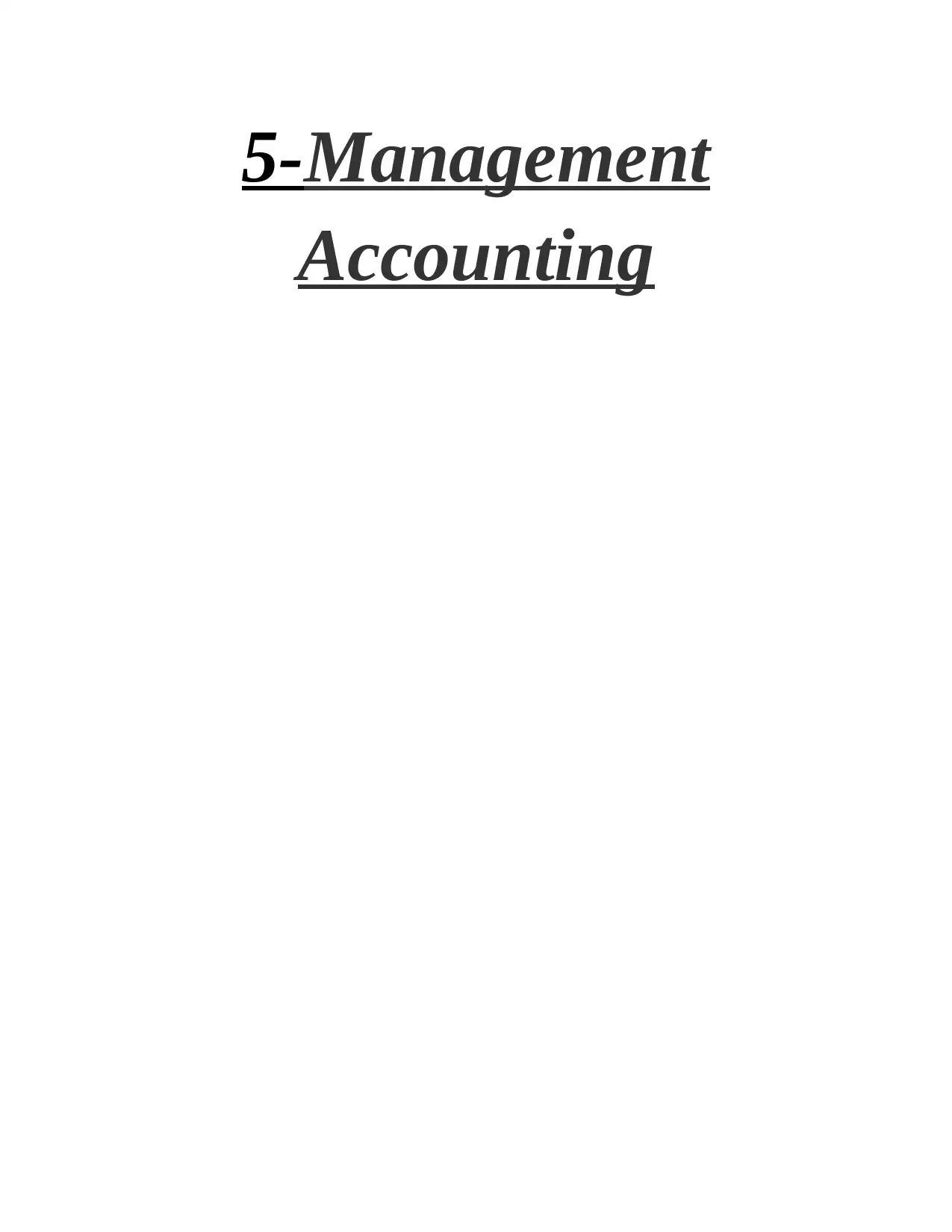
5-Management
Accounting
Accounting
Paraphrase This Document
Need a fresh take? Get an instant paraphrase of this document with our AI Paraphraser
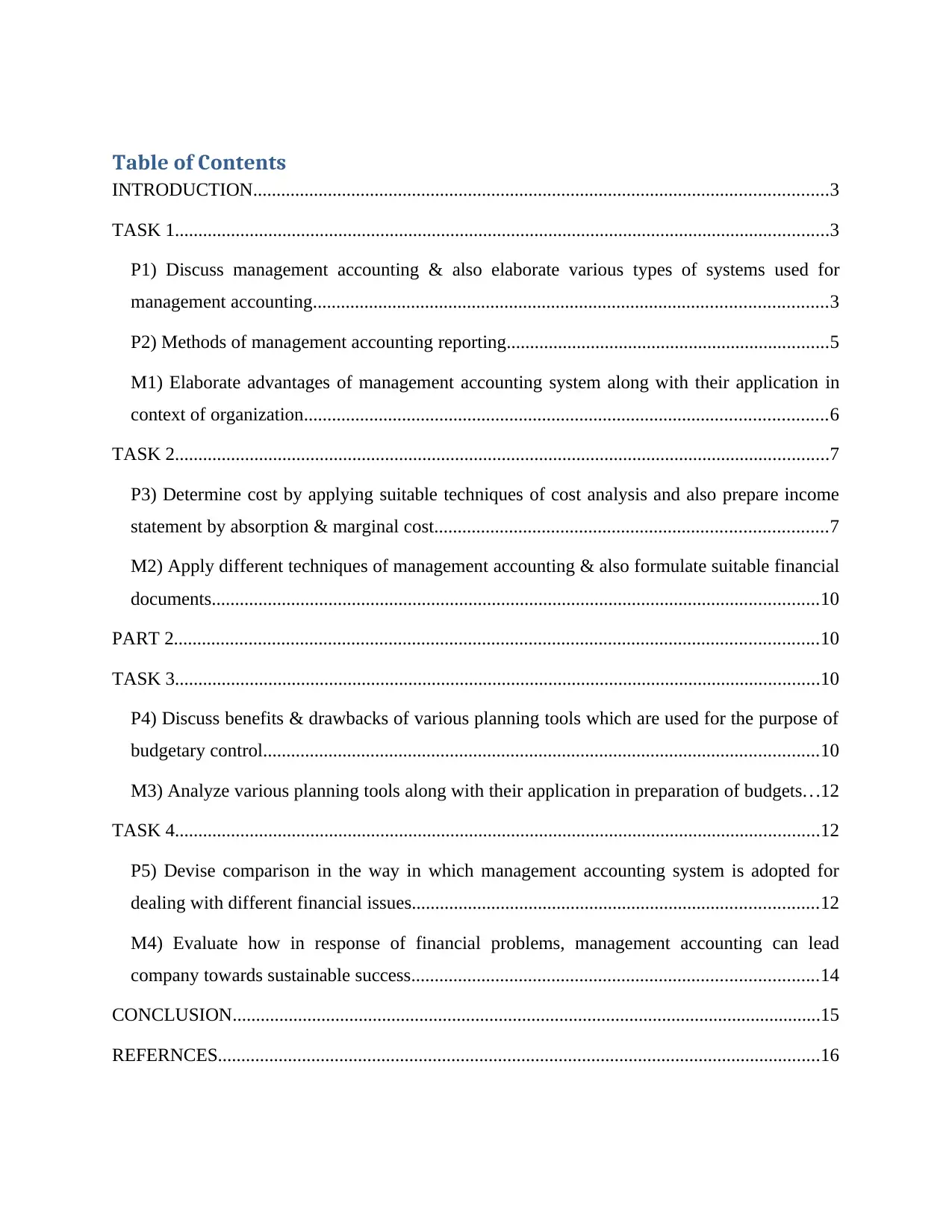
Table of Contents
INTRODUCTION...........................................................................................................................3
TASK 1............................................................................................................................................3
P1) Discuss management accounting & also elaborate various types of systems used for
management accounting..............................................................................................................3
P2) Methods of management accounting reporting.....................................................................5
M1) Elaborate advantages of management accounting system along with their application in
context of organization................................................................................................................6
TASK 2............................................................................................................................................7
P3) Determine cost by applying suitable techniques of cost analysis and also prepare income
statement by absorption & marginal cost....................................................................................7
M2) Apply different techniques of management accounting & also formulate suitable financial
documents..................................................................................................................................10
PART 2..........................................................................................................................................10
TASK 3..........................................................................................................................................10
P4) Discuss benefits & drawbacks of various planning tools which are used for the purpose of
budgetary control.......................................................................................................................10
M3) Analyze various planning tools along with their application in preparation of budgets. . .12
TASK 4..........................................................................................................................................12
P5) Devise comparison in the way in which management accounting system is adopted for
dealing with different financial issues.......................................................................................12
M4) Evaluate how in response of financial problems, management accounting can lead
company towards sustainable success.......................................................................................14
CONCLUSION..............................................................................................................................15
REFERNCES.................................................................................................................................16
INTRODUCTION...........................................................................................................................3
TASK 1............................................................................................................................................3
P1) Discuss management accounting & also elaborate various types of systems used for
management accounting..............................................................................................................3
P2) Methods of management accounting reporting.....................................................................5
M1) Elaborate advantages of management accounting system along with their application in
context of organization................................................................................................................6
TASK 2............................................................................................................................................7
P3) Determine cost by applying suitable techniques of cost analysis and also prepare income
statement by absorption & marginal cost....................................................................................7
M2) Apply different techniques of management accounting & also formulate suitable financial
documents..................................................................................................................................10
PART 2..........................................................................................................................................10
TASK 3..........................................................................................................................................10
P4) Discuss benefits & drawbacks of various planning tools which are used for the purpose of
budgetary control.......................................................................................................................10
M3) Analyze various planning tools along with their application in preparation of budgets. . .12
TASK 4..........................................................................................................................................12
P5) Devise comparison in the way in which management accounting system is adopted for
dealing with different financial issues.......................................................................................12
M4) Evaluate how in response of financial problems, management accounting can lead
company towards sustainable success.......................................................................................14
CONCLUSION..............................................................................................................................15
REFERNCES.................................................................................................................................16

⊘ This is a preview!⊘
Do you want full access?
Subscribe today to unlock all pages.

Trusted by 1+ million students worldwide
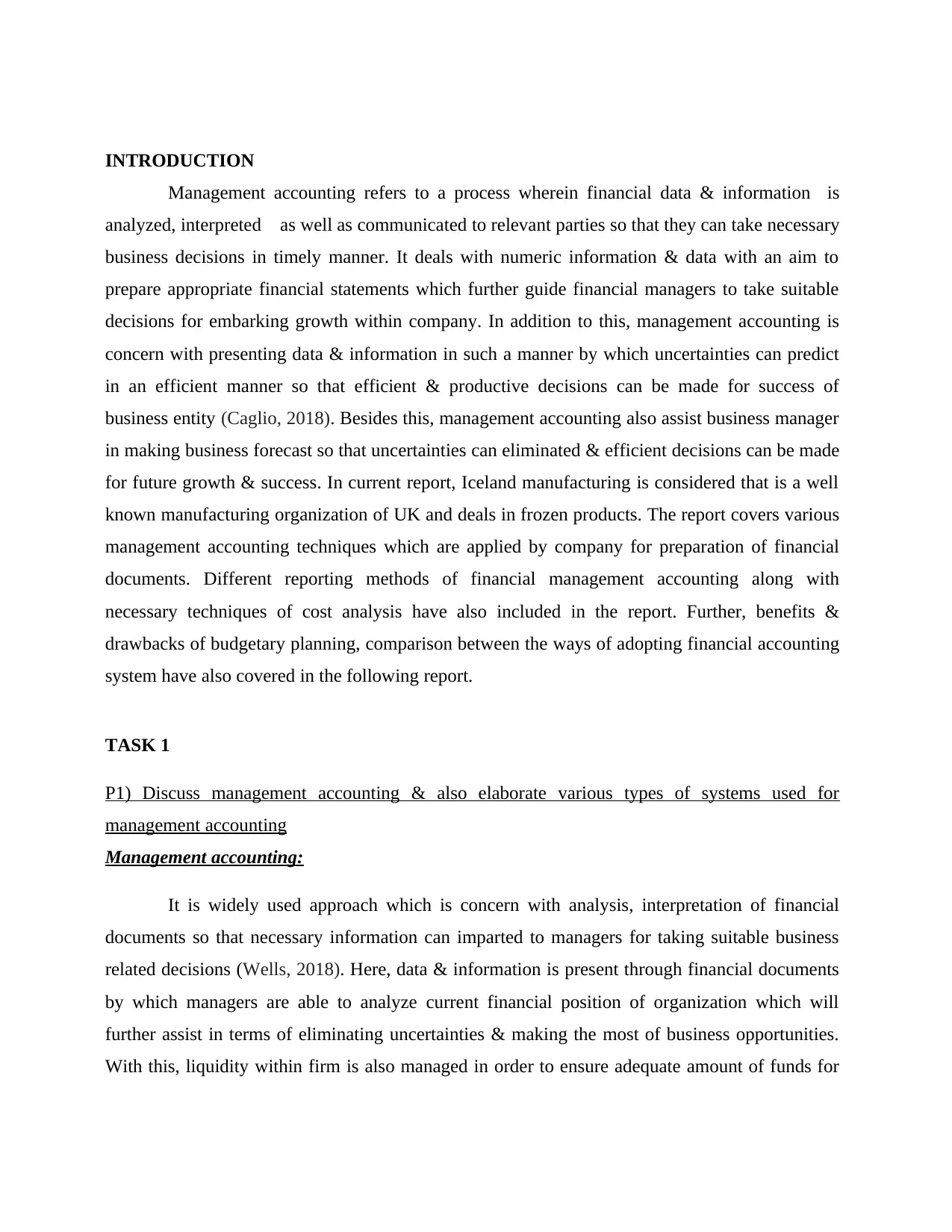
INTRODUCTION
Management accounting refers to a process wherein financial data & information is
analyzed, interpreted as well as communicated to relevant parties so that they can take necessary
business decisions in timely manner. It deals with numeric information & data with an aim to
prepare appropriate financial statements which further guide financial managers to take suitable
decisions for embarking growth within company. In addition to this, management accounting is
concern with presenting data & information in such a manner by which uncertainties can predict
in an efficient manner so that efficient & productive decisions can be made for success of
business entity (Caglio, 2018). Besides this, management accounting also assist business manager
in making business forecast so that uncertainties can eliminated & efficient decisions can be made
for future growth & success. In current report, Iceland manufacturing is considered that is a well
known manufacturing organization of UK and deals in frozen products. The report covers various
management accounting techniques which are applied by company for preparation of financial
documents. Different reporting methods of financial management accounting along with
necessary techniques of cost analysis have also included in the report. Further, benefits &
drawbacks of budgetary planning, comparison between the ways of adopting financial accounting
system have also covered in the following report.
TASK 1
P1) Discuss management accounting & also elaborate various types of systems used for
management accounting
Management accounting:
It is widely used approach which is concern with analysis, interpretation of financial
documents so that necessary information can imparted to managers for taking suitable business
related decisions (Wells, 2018). Here, data & information is present through financial documents
by which managers are able to analyze current financial position of organization which will
further assist in terms of eliminating uncertainties & making the most of business opportunities.
With this, liquidity within firm is also managed in order to ensure adequate amount of funds for
Management accounting refers to a process wherein financial data & information is
analyzed, interpreted as well as communicated to relevant parties so that they can take necessary
business decisions in timely manner. It deals with numeric information & data with an aim to
prepare appropriate financial statements which further guide financial managers to take suitable
decisions for embarking growth within company. In addition to this, management accounting is
concern with presenting data & information in such a manner by which uncertainties can predict
in an efficient manner so that efficient & productive decisions can be made for success of
business entity (Caglio, 2018). Besides this, management accounting also assist business manager
in making business forecast so that uncertainties can eliminated & efficient decisions can be made
for future growth & success. In current report, Iceland manufacturing is considered that is a well
known manufacturing organization of UK and deals in frozen products. The report covers various
management accounting techniques which are applied by company for preparation of financial
documents. Different reporting methods of financial management accounting along with
necessary techniques of cost analysis have also included in the report. Further, benefits &
drawbacks of budgetary planning, comparison between the ways of adopting financial accounting
system have also covered in the following report.
TASK 1
P1) Discuss management accounting & also elaborate various types of systems used for
management accounting
Management accounting:
It is widely used approach which is concern with analysis, interpretation of financial
documents so that necessary information can imparted to managers for taking suitable business
related decisions (Wells, 2018). Here, data & information is present through financial documents
by which managers are able to analyze current financial position of organization which will
further assist in terms of eliminating uncertainties & making the most of business opportunities.
With this, liquidity within firm is also managed in order to ensure adequate amount of funds for
Paraphrase This Document
Need a fresh take? Get an instant paraphrase of this document with our AI Paraphraser
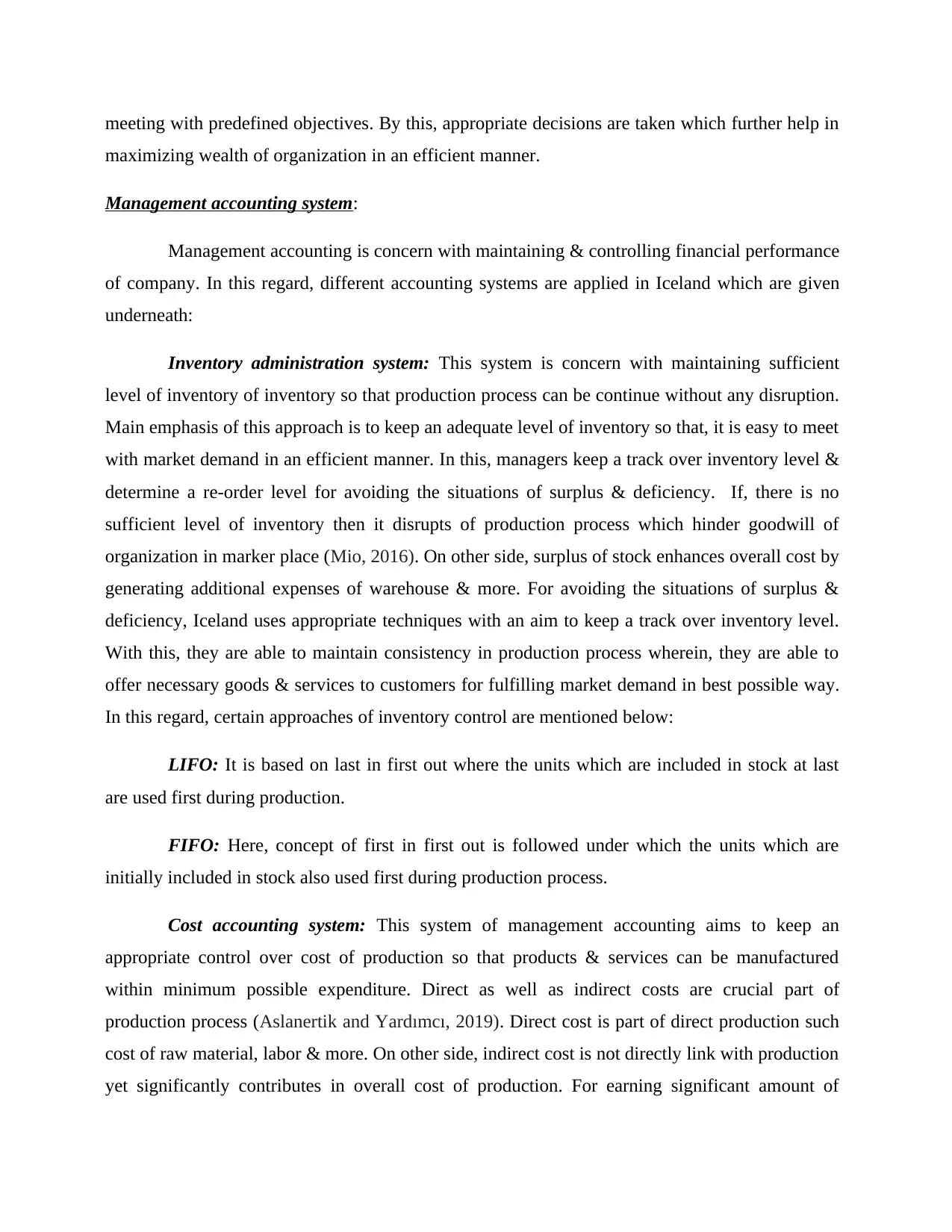
meeting with predefined objectives. By this, appropriate decisions are taken which further help in
maximizing wealth of organization in an efficient manner.
Management accounting system:
Management accounting is concern with maintaining & controlling financial performance
of company. In this regard, different accounting systems are applied in Iceland which are given
underneath:
Inventory administration system: This system is concern with maintaining sufficient
level of inventory of inventory so that production process can be continue without any disruption.
Main emphasis of this approach is to keep an adequate level of inventory so that, it is easy to meet
with market demand in an efficient manner. In this, managers keep a track over inventory level &
determine a re-order level for avoiding the situations of surplus & deficiency. If, there is no
sufficient level of inventory then it disrupts of production process which hinder goodwill of
organization in marker place (Mio, 2016). On other side, surplus of stock enhances overall cost by
generating additional expenses of warehouse & more. For avoiding the situations of surplus &
deficiency, Iceland uses appropriate techniques with an aim to keep a track over inventory level.
With this, they are able to maintain consistency in production process wherein, they are able to
offer necessary goods & services to customers for fulfilling market demand in best possible way.
In this regard, certain approaches of inventory control are mentioned below:
LIFO: It is based on last in first out where the units which are included in stock at last
are used first during production.
FIFO: Here, concept of first in first out is followed under which the units which are
initially included in stock also used first during production process.
Cost accounting system: This system of management accounting aims to keep an
appropriate control over cost of production so that products & services can be manufactured
within minimum possible expenditure. Direct as well as indirect costs are crucial part of
production process (Aslanertik and Yardımcı, 2019). Direct cost is part of direct production such
cost of raw material, labor & more. On other side, indirect cost is not directly link with production
yet significantly contributes in overall cost of production. For earning significant amount of
maximizing wealth of organization in an efficient manner.
Management accounting system:
Management accounting is concern with maintaining & controlling financial performance
of company. In this regard, different accounting systems are applied in Iceland which are given
underneath:
Inventory administration system: This system is concern with maintaining sufficient
level of inventory of inventory so that production process can be continue without any disruption.
Main emphasis of this approach is to keep an adequate level of inventory so that, it is easy to meet
with market demand in an efficient manner. In this, managers keep a track over inventory level &
determine a re-order level for avoiding the situations of surplus & deficiency. If, there is no
sufficient level of inventory then it disrupts of production process which hinder goodwill of
organization in marker place (Mio, 2016). On other side, surplus of stock enhances overall cost by
generating additional expenses of warehouse & more. For avoiding the situations of surplus &
deficiency, Iceland uses appropriate techniques with an aim to keep a track over inventory level.
With this, they are able to maintain consistency in production process wherein, they are able to
offer necessary goods & services to customers for fulfilling market demand in best possible way.
In this regard, certain approaches of inventory control are mentioned below:
LIFO: It is based on last in first out where the units which are included in stock at last
are used first during production.
FIFO: Here, concept of first in first out is followed under which the units which are
initially included in stock also used first during production process.
Cost accounting system: This system of management accounting aims to keep an
appropriate control over cost of production so that products & services can be manufactured
within minimum possible expenditure. Direct as well as indirect costs are crucial part of
production process (Aslanertik and Yardımcı, 2019). Direct cost is part of direct production such
cost of raw material, labor & more. On other side, indirect cost is not directly link with production
yet significantly contributes in overall cost of production. For earning significant amount of
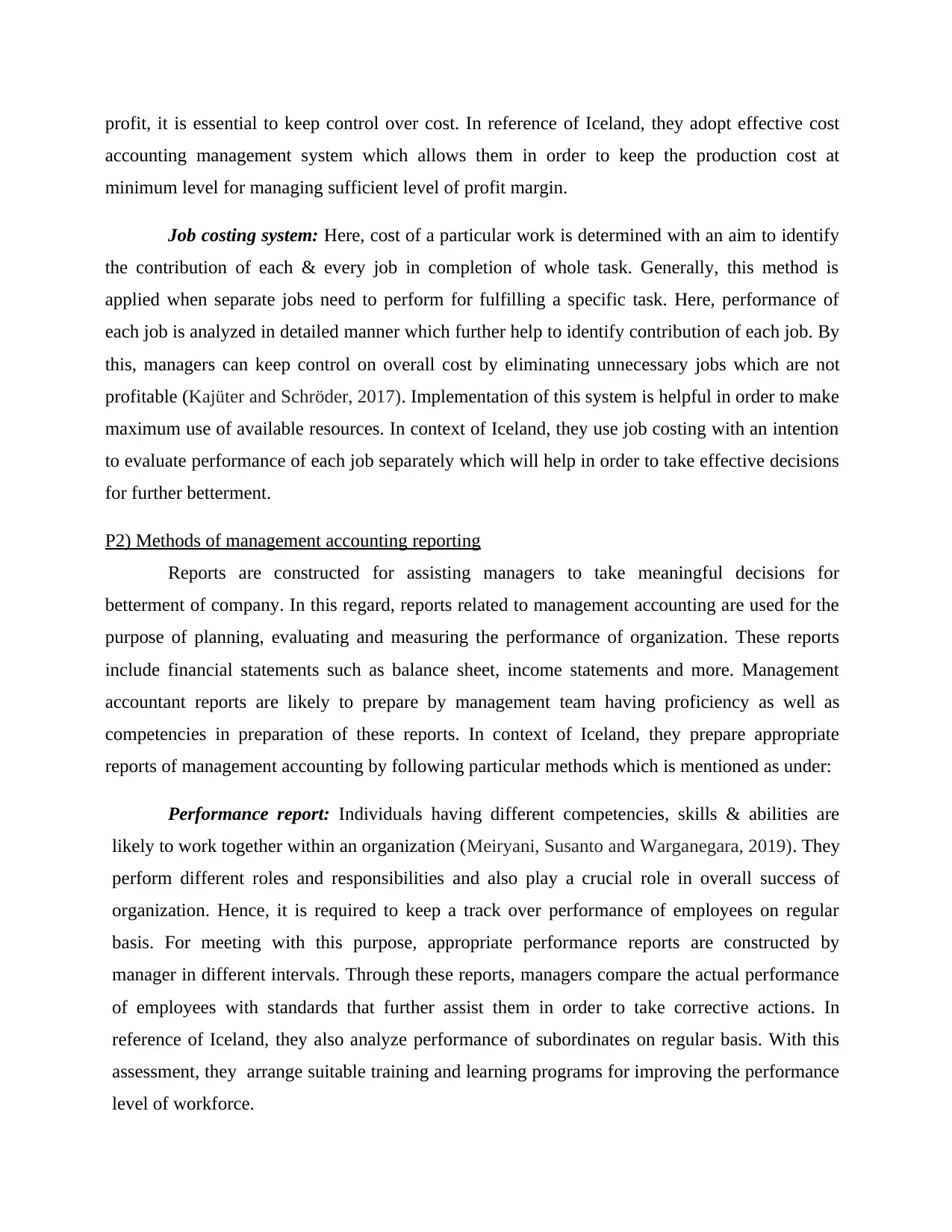
profit, it is essential to keep control over cost. In reference of Iceland, they adopt effective cost
accounting management system which allows them in order to keep the production cost at
minimum level for managing sufficient level of profit margin.
Job costing system: Here, cost of a particular work is determined with an aim to identify
the contribution of each & every job in completion of whole task. Generally, this method is
applied when separate jobs need to perform for fulfilling a specific task. Here, performance of
each job is analyzed in detailed manner which further help to identify contribution of each job. By
this, managers can keep control on overall cost by eliminating unnecessary jobs which are not
profitable (Kajüter and Schröder, 2017). Implementation of this system is helpful in order to make
maximum use of available resources. In context of Iceland, they use job costing with an intention
to evaluate performance of each job separately which will help in order to take effective decisions
for further betterment.
P2) Methods of management accounting reporting
Reports are constructed for assisting managers to take meaningful decisions for
betterment of company. In this regard, reports related to management accounting are used for the
purpose of planning, evaluating and measuring the performance of organization. These reports
include financial statements such as balance sheet, income statements and more. Management
accountant reports are likely to prepare by management team having proficiency as well as
competencies in preparation of these reports. In context of Iceland, they prepare appropriate
reports of management accounting by following particular methods which is mentioned as under:
Performance report: Individuals having different competencies, skills & abilities are
likely to work together within an organization (Meiryani, Susanto and Warganegara, 2019). They
perform different roles and responsibilities and also play a crucial role in overall success of
organization. Hence, it is required to keep a track over performance of employees on regular
basis. For meeting with this purpose, appropriate performance reports are constructed by
manager in different intervals. Through these reports, managers compare the actual performance
of employees with standards that further assist them in order to take corrective actions. In
reference of Iceland, they also analyze performance of subordinates on regular basis. With this
assessment, they arrange suitable training and learning programs for improving the performance
level of workforce.
accounting management system which allows them in order to keep the production cost at
minimum level for managing sufficient level of profit margin.
Job costing system: Here, cost of a particular work is determined with an aim to identify
the contribution of each & every job in completion of whole task. Generally, this method is
applied when separate jobs need to perform for fulfilling a specific task. Here, performance of
each job is analyzed in detailed manner which further help to identify contribution of each job. By
this, managers can keep control on overall cost by eliminating unnecessary jobs which are not
profitable (Kajüter and Schröder, 2017). Implementation of this system is helpful in order to make
maximum use of available resources. In context of Iceland, they use job costing with an intention
to evaluate performance of each job separately which will help in order to take effective decisions
for further betterment.
P2) Methods of management accounting reporting
Reports are constructed for assisting managers to take meaningful decisions for
betterment of company. In this regard, reports related to management accounting are used for the
purpose of planning, evaluating and measuring the performance of organization. These reports
include financial statements such as balance sheet, income statements and more. Management
accountant reports are likely to prepare by management team having proficiency as well as
competencies in preparation of these reports. In context of Iceland, they prepare appropriate
reports of management accounting by following particular methods which is mentioned as under:
Performance report: Individuals having different competencies, skills & abilities are
likely to work together within an organization (Meiryani, Susanto and Warganegara, 2019). They
perform different roles and responsibilities and also play a crucial role in overall success of
organization. Hence, it is required to keep a track over performance of employees on regular
basis. For meeting with this purpose, appropriate performance reports are constructed by
manager in different intervals. Through these reports, managers compare the actual performance
of employees with standards that further assist them in order to take corrective actions. In
reference of Iceland, they also analyze performance of subordinates on regular basis. With this
assessment, they arrange suitable training and learning programs for improving the performance
level of workforce.
⊘ This is a preview!⊘
Do you want full access?
Subscribe today to unlock all pages.

Trusted by 1+ million students worldwide
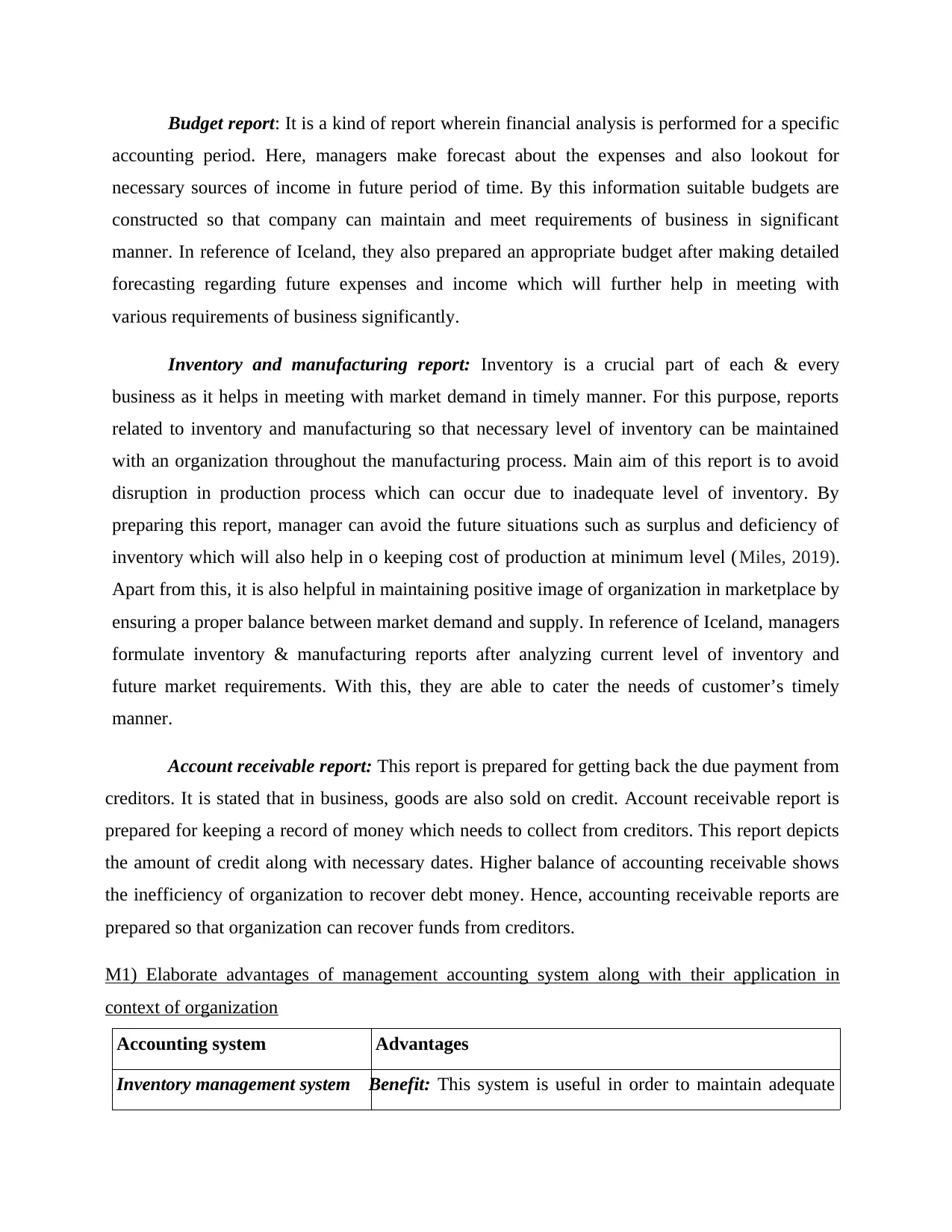
Budget report: It is a kind of report wherein financial analysis is performed for a specific
accounting period. Here, managers make forecast about the expenses and also lookout for
necessary sources of income in future period of time. By this information suitable budgets are
constructed so that company can maintain and meet requirements of business in significant
manner. In reference of Iceland, they also prepared an appropriate budget after making detailed
forecasting regarding future expenses and income which will further help in meeting with
various requirements of business significantly.
Inventory and manufacturing report: Inventory is a crucial part of each & every
business as it helps in meeting with market demand in timely manner. For this purpose, reports
related to inventory and manufacturing so that necessary level of inventory can be maintained
with an organization throughout the manufacturing process. Main aim of this report is to avoid
disruption in production process which can occur due to inadequate level of inventory. By
preparing this report, manager can avoid the future situations such as surplus and deficiency of
inventory which will also help in o keeping cost of production at minimum level (Miles, 2019).
Apart from this, it is also helpful in maintaining positive image of organization in marketplace by
ensuring a proper balance between market demand and supply. In reference of Iceland, managers
formulate inventory & manufacturing reports after analyzing current level of inventory and
future market requirements. With this, they are able to cater the needs of customer’s timely
manner.
Account receivable report: This report is prepared for getting back the due payment from
creditors. It is stated that in business, goods are also sold on credit. Account receivable report is
prepared for keeping a record of money which needs to collect from creditors. This report depicts
the amount of credit along with necessary dates. Higher balance of accounting receivable shows
the inefficiency of organization to recover debt money. Hence, accounting receivable reports are
prepared so that organization can recover funds from creditors.
M1) Elaborate advantages of management accounting system along with their application in
context of organization
Accounting system Advantages
Inventory management system Benefit: This system is useful in order to maintain adequate
accounting period. Here, managers make forecast about the expenses and also lookout for
necessary sources of income in future period of time. By this information suitable budgets are
constructed so that company can maintain and meet requirements of business in significant
manner. In reference of Iceland, they also prepared an appropriate budget after making detailed
forecasting regarding future expenses and income which will further help in meeting with
various requirements of business significantly.
Inventory and manufacturing report: Inventory is a crucial part of each & every
business as it helps in meeting with market demand in timely manner. For this purpose, reports
related to inventory and manufacturing so that necessary level of inventory can be maintained
with an organization throughout the manufacturing process. Main aim of this report is to avoid
disruption in production process which can occur due to inadequate level of inventory. By
preparing this report, manager can avoid the future situations such as surplus and deficiency of
inventory which will also help in o keeping cost of production at minimum level (Miles, 2019).
Apart from this, it is also helpful in maintaining positive image of organization in marketplace by
ensuring a proper balance between market demand and supply. In reference of Iceland, managers
formulate inventory & manufacturing reports after analyzing current level of inventory and
future market requirements. With this, they are able to cater the needs of customer’s timely
manner.
Account receivable report: This report is prepared for getting back the due payment from
creditors. It is stated that in business, goods are also sold on credit. Account receivable report is
prepared for keeping a record of money which needs to collect from creditors. This report depicts
the amount of credit along with necessary dates. Higher balance of accounting receivable shows
the inefficiency of organization to recover debt money. Hence, accounting receivable reports are
prepared so that organization can recover funds from creditors.
M1) Elaborate advantages of management accounting system along with their application in
context of organization
Accounting system Advantages
Inventory management system Benefit: This system is useful in order to maintain adequate
Paraphrase This Document
Need a fresh take? Get an instant paraphrase of this document with our AI Paraphraser
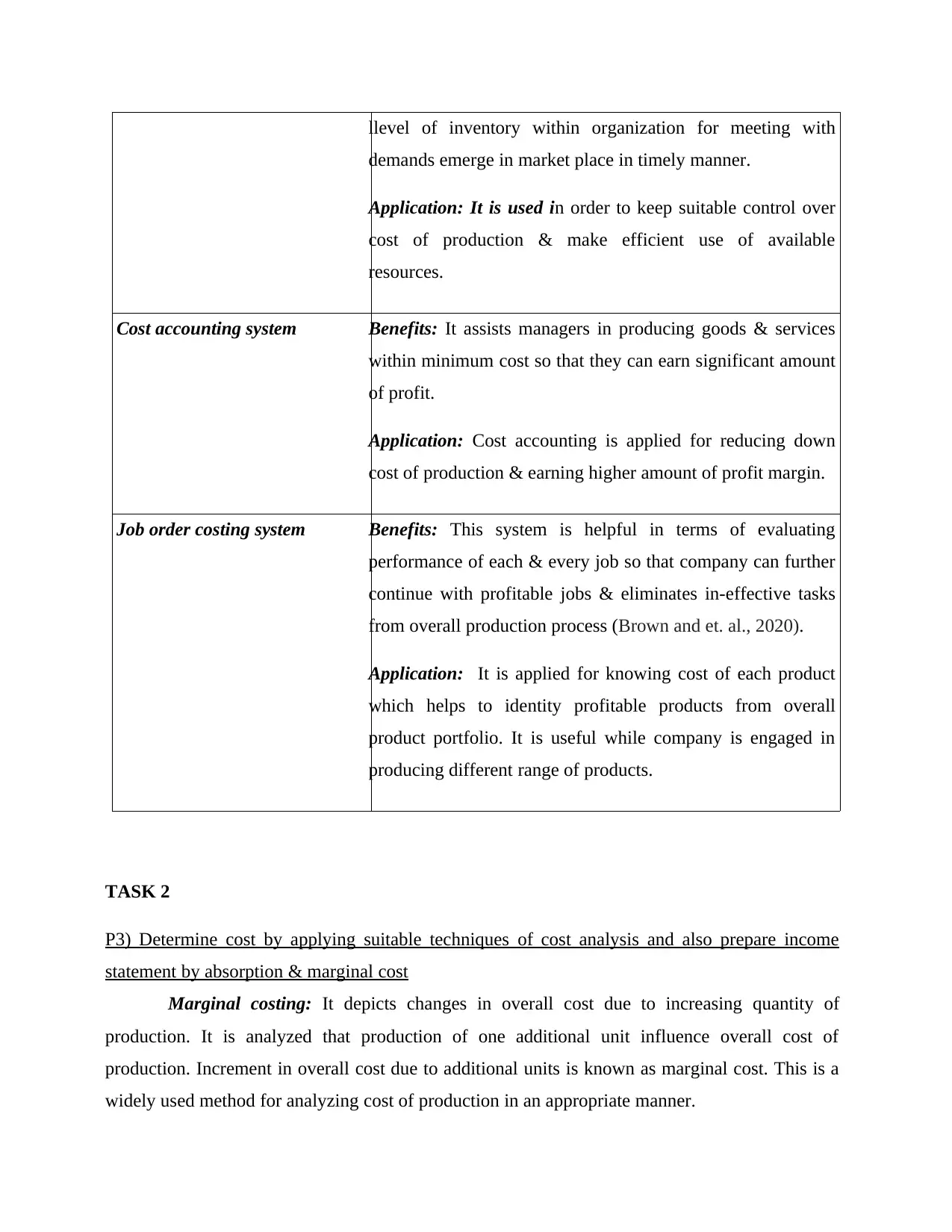
llevel of inventory within organization for meeting with
demands emerge in market place in timely manner.
Application: It is used in order to keep suitable control over
cost of production & make efficient use of available
resources.
Cost accounting system Benefits: It assists managers in producing goods & services
within minimum cost so that they can earn significant amount
of profit.
Application: Cost accounting is applied for reducing down
cost of production & earning higher amount of profit margin.
Job order costing system Benefits: This system is helpful in terms of evaluating
performance of each & every job so that company can further
continue with profitable jobs & eliminates in-effective tasks
from overall production process (Brown and et. al., 2020).
Application: It is applied for knowing cost of each product
which helps to identity profitable products from overall
product portfolio. It is useful while company is engaged in
producing different range of products.
TASK 2
P3) Determine cost by applying suitable techniques of cost analysis and also prepare income
statement by absorption & marginal cost
Marginal costing: It depicts changes in overall cost due to increasing quantity of
production. It is analyzed that production of one additional unit influence overall cost of
production. Increment in overall cost due to additional units is known as marginal cost. This is a
widely used method for analyzing cost of production in an appropriate manner.
demands emerge in market place in timely manner.
Application: It is used in order to keep suitable control over
cost of production & make efficient use of available
resources.
Cost accounting system Benefits: It assists managers in producing goods & services
within minimum cost so that they can earn significant amount
of profit.
Application: Cost accounting is applied for reducing down
cost of production & earning higher amount of profit margin.
Job order costing system Benefits: This system is helpful in terms of evaluating
performance of each & every job so that company can further
continue with profitable jobs & eliminates in-effective tasks
from overall production process (Brown and et. al., 2020).
Application: It is applied for knowing cost of each product
which helps to identity profitable products from overall
product portfolio. It is useful while company is engaged in
producing different range of products.
TASK 2
P3) Determine cost by applying suitable techniques of cost analysis and also prepare income
statement by absorption & marginal cost
Marginal costing: It depicts changes in overall cost due to increasing quantity of
production. It is analyzed that production of one additional unit influence overall cost of
production. Increment in overall cost due to additional units is known as marginal cost. This is a
widely used method for analyzing cost of production in an appropriate manner.
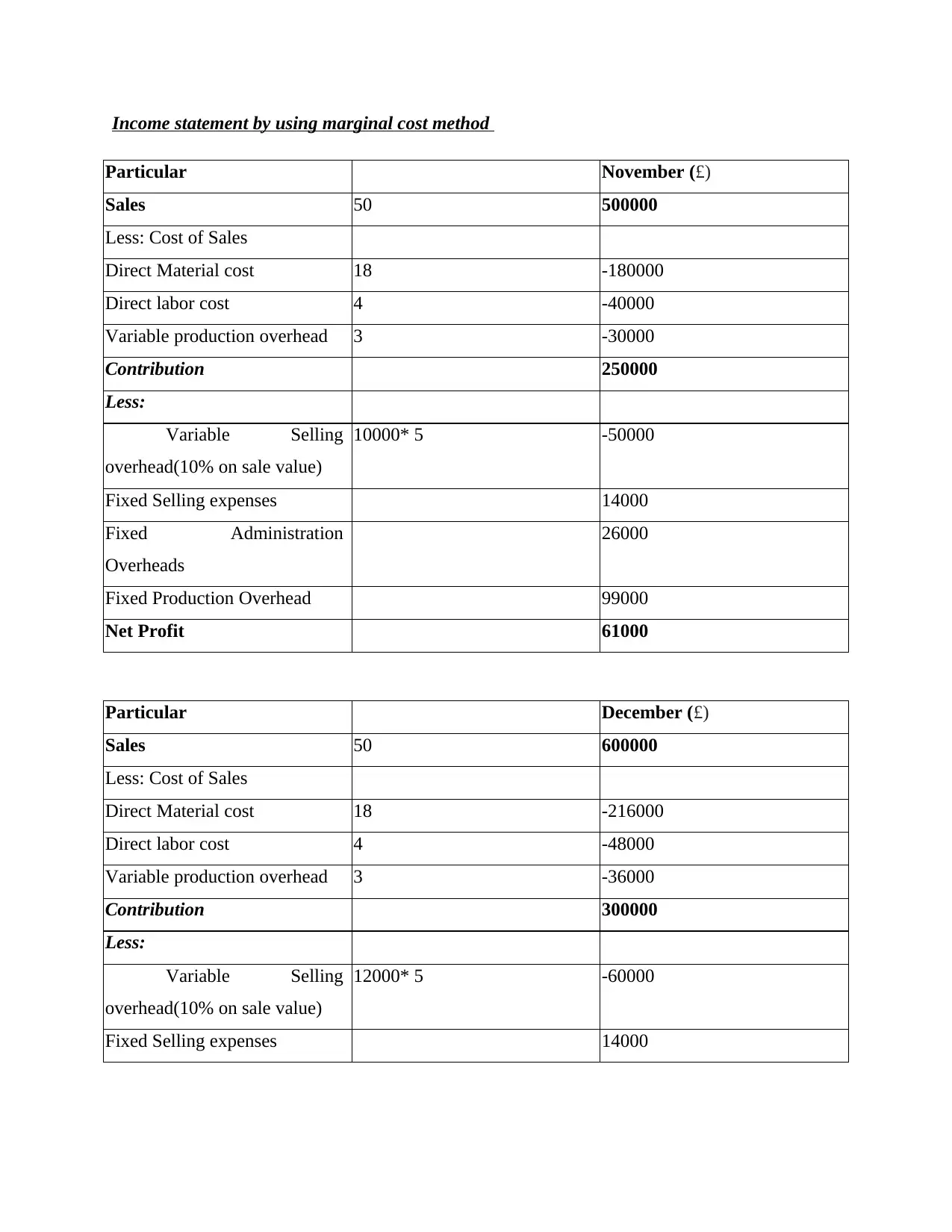
Income statement by using marginal cost method
Particular November (£)
Sales 50 500000
Less: Cost of Sales
Direct Material cost 18 -180000
Direct labor cost 4 -40000
Variable production overhead 3 -30000
Contribution 250000
Less:
Variable Selling
overhead(10% on sale value)
10000* 5 -50000
Fixed Selling expenses 14000
Fixed Administration
Overheads
26000
Fixed Production Overhead 99000
Net Profit 61000
Particular December (£)
Sales 50 600000
Less: Cost of Sales
Direct Material cost 18 -216000
Direct labor cost 4 -48000
Variable production overhead 3 -36000
Contribution 300000
Less:
Variable Selling
overhead(10% on sale value)
12000* 5 -60000
Fixed Selling expenses 14000
Particular November (£)
Sales 50 500000
Less: Cost of Sales
Direct Material cost 18 -180000
Direct labor cost 4 -40000
Variable production overhead 3 -30000
Contribution 250000
Less:
Variable Selling
overhead(10% on sale value)
10000* 5 -50000
Fixed Selling expenses 14000
Fixed Administration
Overheads
26000
Fixed Production Overhead 99000
Net Profit 61000
Particular December (£)
Sales 50 600000
Less: Cost of Sales
Direct Material cost 18 -216000
Direct labor cost 4 -48000
Variable production overhead 3 -36000
Contribution 300000
Less:
Variable Selling
overhead(10% on sale value)
12000* 5 -60000
Fixed Selling expenses 14000
⊘ This is a preview!⊘
Do you want full access?
Subscribe today to unlock all pages.

Trusted by 1+ million students worldwide
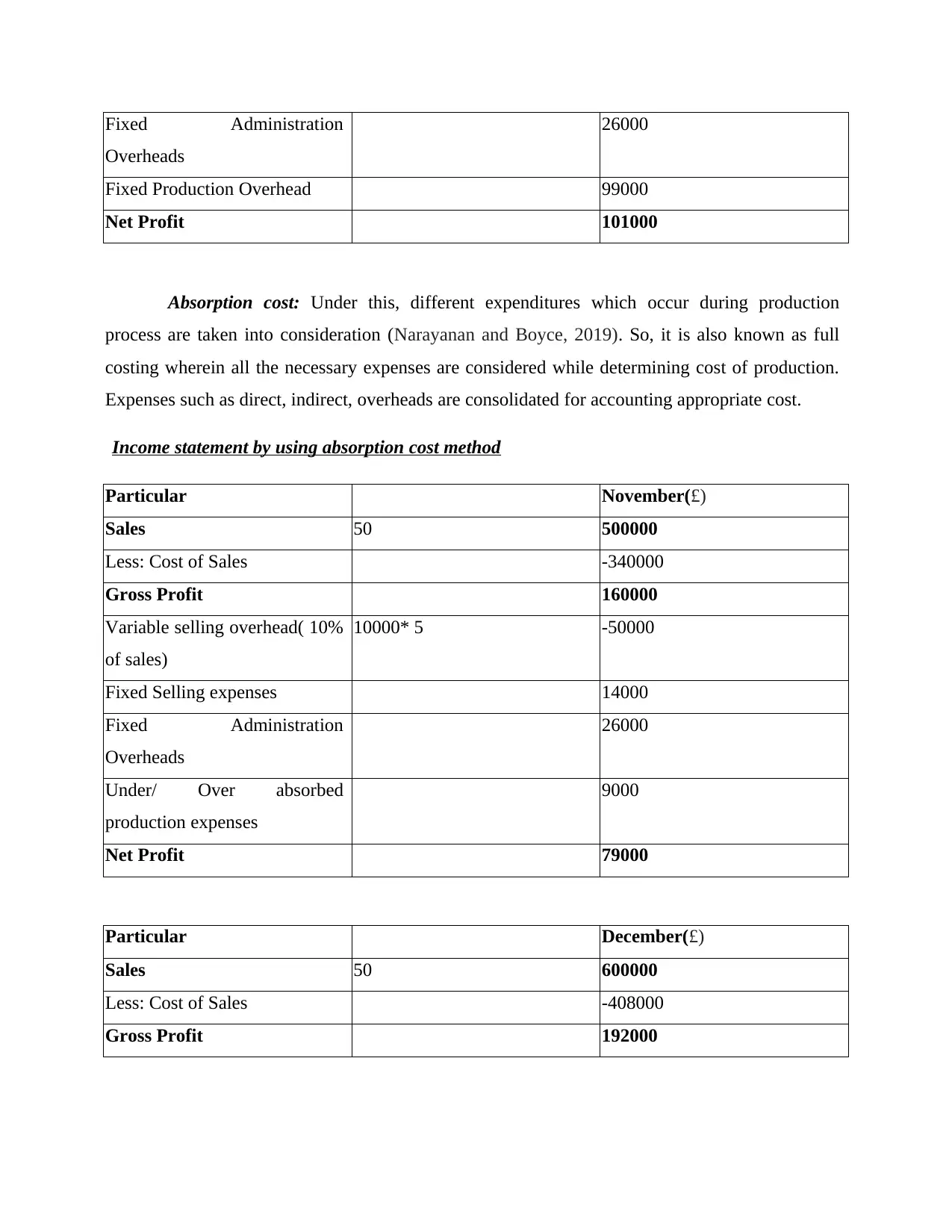
Fixed Administration
Overheads
26000
Fixed Production Overhead 99000
Net Profit 101000
Absorption cost: Under this, different expenditures which occur during production
process are taken into consideration (Narayanan and Boyce, 2019). So, it is also known as full
costing wherein all the necessary expenses are considered while determining cost of production.
Expenses such as direct, indirect, overheads are consolidated for accounting appropriate cost.
Income statement by using absorption cost method
Particular November(£)
Sales 50 500000
Less: Cost of Sales -340000
Gross Profit 160000
Variable selling overhead( 10%
of sales)
10000* 5 -50000
Fixed Selling expenses 14000
Fixed Administration
Overheads
26000
Under/ Over absorbed
production expenses
9000
Net Profit 79000
Particular December(£)
Sales 50 600000
Less: Cost of Sales -408000
Gross Profit 192000
Overheads
26000
Fixed Production Overhead 99000
Net Profit 101000
Absorption cost: Under this, different expenditures which occur during production
process are taken into consideration (Narayanan and Boyce, 2019). So, it is also known as full
costing wherein all the necessary expenses are considered while determining cost of production.
Expenses such as direct, indirect, overheads are consolidated for accounting appropriate cost.
Income statement by using absorption cost method
Particular November(£)
Sales 50 500000
Less: Cost of Sales -340000
Gross Profit 160000
Variable selling overhead( 10%
of sales)
10000* 5 -50000
Fixed Selling expenses 14000
Fixed Administration
Overheads
26000
Under/ Over absorbed
production expenses
9000
Net Profit 79000
Particular December(£)
Sales 50 600000
Less: Cost of Sales -408000
Gross Profit 192000
Paraphrase This Document
Need a fresh take? Get an instant paraphrase of this document with our AI Paraphraser
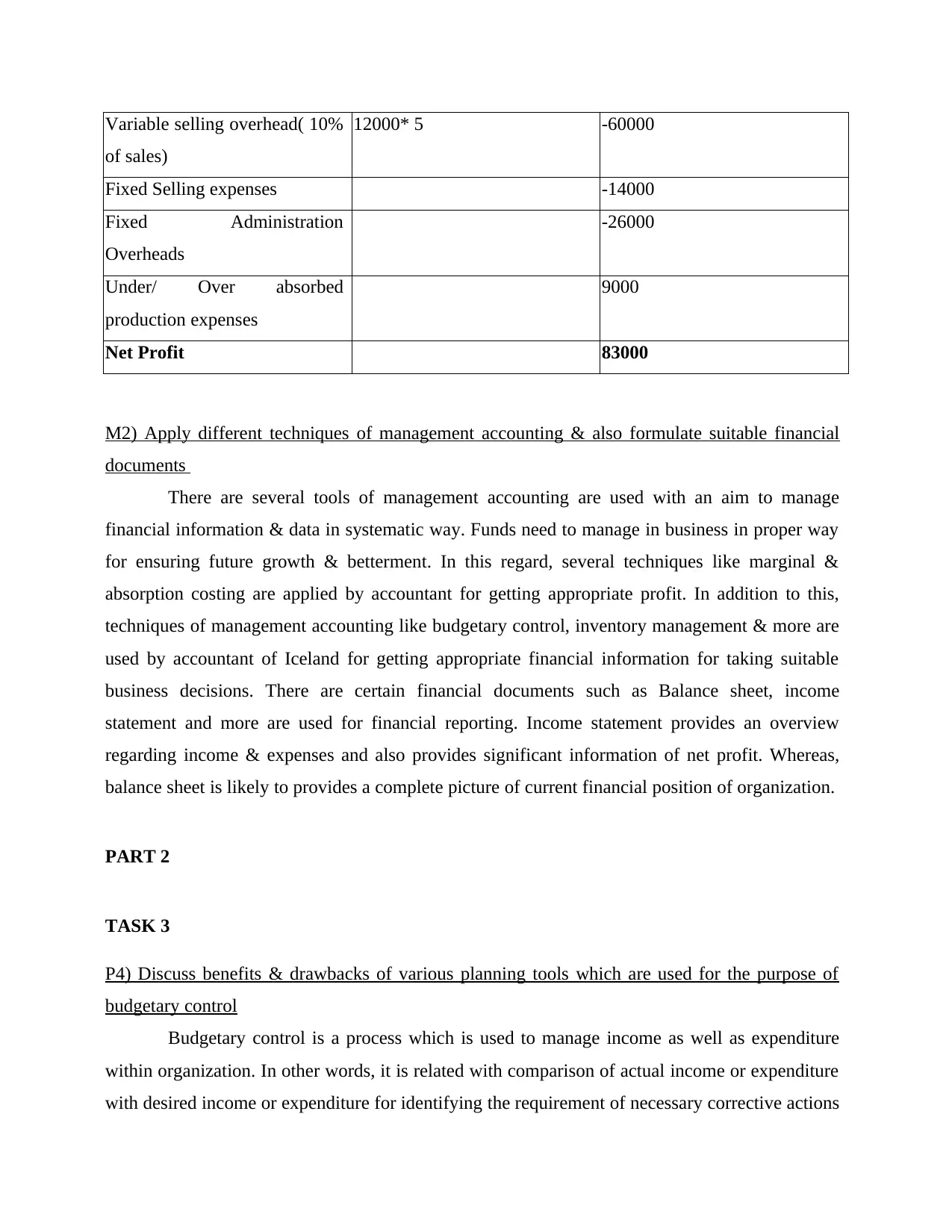
Variable selling overhead( 10%
of sales)
12000* 5 -60000
Fixed Selling expenses -14000
Fixed Administration
Overheads
-26000
Under/ Over absorbed
production expenses
9000
Net Profit 83000
M2) Apply different techniques of management accounting & also formulate suitable financial
documents
There are several tools of management accounting are used with an aim to manage
financial information & data in systematic way. Funds need to manage in business in proper way
for ensuring future growth & betterment. In this regard, several techniques like marginal &
absorption costing are applied by accountant for getting appropriate profit. In addition to this,
techniques of management accounting like budgetary control, inventory management & more are
used by accountant of Iceland for getting appropriate financial information for taking suitable
business decisions. There are certain financial documents such as Balance sheet, income
statement and more are used for financial reporting. Income statement provides an overview
regarding income & expenses and also provides significant information of net profit. Whereas,
balance sheet is likely to provides a complete picture of current financial position of organization.
PART 2
TASK 3
P4) Discuss benefits & drawbacks of various planning tools which are used for the purpose of
budgetary control
Budgetary control is a process which is used to manage income as well as expenditure
within organization. In other words, it is related with comparison of actual income or expenditure
with desired income or expenditure for identifying the requirement of necessary corrective actions
of sales)
12000* 5 -60000
Fixed Selling expenses -14000
Fixed Administration
Overheads
-26000
Under/ Over absorbed
production expenses
9000
Net Profit 83000
M2) Apply different techniques of management accounting & also formulate suitable financial
documents
There are several tools of management accounting are used with an aim to manage
financial information & data in systematic way. Funds need to manage in business in proper way
for ensuring future growth & betterment. In this regard, several techniques like marginal &
absorption costing are applied by accountant for getting appropriate profit. In addition to this,
techniques of management accounting like budgetary control, inventory management & more are
used by accountant of Iceland for getting appropriate financial information for taking suitable
business decisions. There are certain financial documents such as Balance sheet, income
statement and more are used for financial reporting. Income statement provides an overview
regarding income & expenses and also provides significant information of net profit. Whereas,
balance sheet is likely to provides a complete picture of current financial position of organization.
PART 2
TASK 3
P4) Discuss benefits & drawbacks of various planning tools which are used for the purpose of
budgetary control
Budgetary control is a process which is used to manage income as well as expenditure
within organization. In other words, it is related with comparison of actual income or expenditure
with desired income or expenditure for identifying the requirement of necessary corrective actions
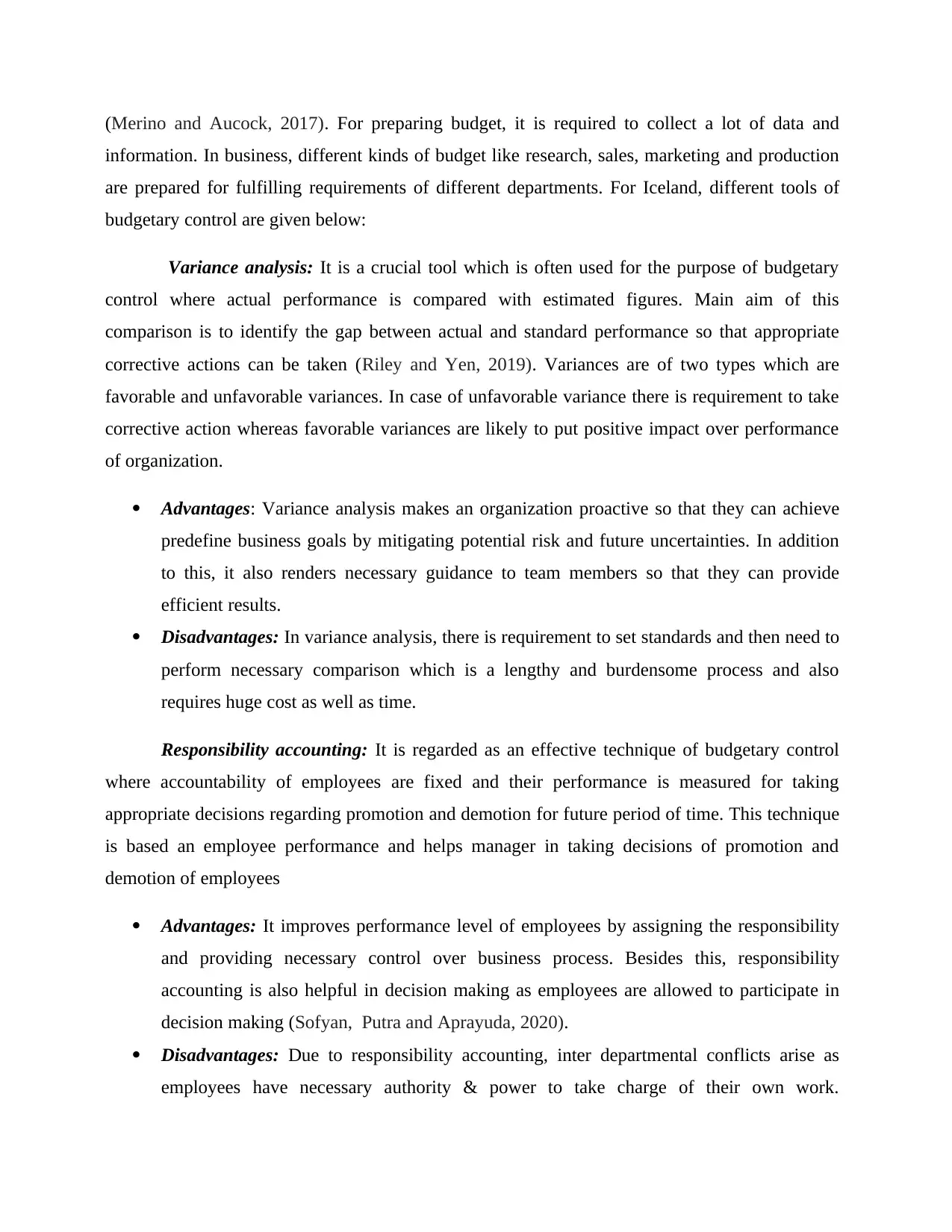
(Merino and Aucock, 2017). For preparing budget, it is required to collect a lot of data and
information. In business, different kinds of budget like research, sales, marketing and production
are prepared for fulfilling requirements of different departments. For Iceland, different tools of
budgetary control are given below:
Variance analysis: It is a crucial tool which is often used for the purpose of budgetary
control where actual performance is compared with estimated figures. Main aim of this
comparison is to identify the gap between actual and standard performance so that appropriate
corrective actions can be taken (Riley and Yen, 2019). Variances are of two types which are
favorable and unfavorable variances. In case of unfavorable variance there is requirement to take
corrective action whereas favorable variances are likely to put positive impact over performance
of organization.
Advantages: Variance analysis makes an organization proactive so that they can achieve
predefine business goals by mitigating potential risk and future uncertainties. In addition
to this, it also renders necessary guidance to team members so that they can provide
efficient results.
Disadvantages: In variance analysis, there is requirement to set standards and then need to
perform necessary comparison which is a lengthy and burdensome process and also
requires huge cost as well as time.
Responsibility accounting: It is regarded as an effective technique of budgetary control
where accountability of employees are fixed and their performance is measured for taking
appropriate decisions regarding promotion and demotion for future period of time. This technique
is based an employee performance and helps manager in taking decisions of promotion and
demotion of employees
Advantages: It improves performance level of employees by assigning the responsibility
and providing necessary control over business process. Besides this, responsibility
accounting is also helpful in decision making as employees are allowed to participate in
decision making (Sofyan, Putra and Aprayuda, 2020).
Disadvantages: Due to responsibility accounting, inter departmental conflicts arise as
employees have necessary authority & power to take charge of their own work.
information. In business, different kinds of budget like research, sales, marketing and production
are prepared for fulfilling requirements of different departments. For Iceland, different tools of
budgetary control are given below:
Variance analysis: It is a crucial tool which is often used for the purpose of budgetary
control where actual performance is compared with estimated figures. Main aim of this
comparison is to identify the gap between actual and standard performance so that appropriate
corrective actions can be taken (Riley and Yen, 2019). Variances are of two types which are
favorable and unfavorable variances. In case of unfavorable variance there is requirement to take
corrective action whereas favorable variances are likely to put positive impact over performance
of organization.
Advantages: Variance analysis makes an organization proactive so that they can achieve
predefine business goals by mitigating potential risk and future uncertainties. In addition
to this, it also renders necessary guidance to team members so that they can provide
efficient results.
Disadvantages: In variance analysis, there is requirement to set standards and then need to
perform necessary comparison which is a lengthy and burdensome process and also
requires huge cost as well as time.
Responsibility accounting: It is regarded as an effective technique of budgetary control
where accountability of employees are fixed and their performance is measured for taking
appropriate decisions regarding promotion and demotion for future period of time. This technique
is based an employee performance and helps manager in taking decisions of promotion and
demotion of employees
Advantages: It improves performance level of employees by assigning the responsibility
and providing necessary control over business process. Besides this, responsibility
accounting is also helpful in decision making as employees are allowed to participate in
decision making (Sofyan, Putra and Aprayuda, 2020).
Disadvantages: Due to responsibility accounting, inter departmental conflicts arise as
employees have necessary authority & power to take charge of their own work.
⊘ This is a preview!⊘
Do you want full access?
Subscribe today to unlock all pages.

Trusted by 1+ million students worldwide
1 out of 18
Related Documents
Your All-in-One AI-Powered Toolkit for Academic Success.
+13062052269
info@desklib.com
Available 24*7 on WhatsApp / Email
![[object Object]](/_next/static/media/star-bottom.7253800d.svg)
Unlock your academic potential
Copyright © 2020–2025 A2Z Services. All Rights Reserved. Developed and managed by ZUCOL.





